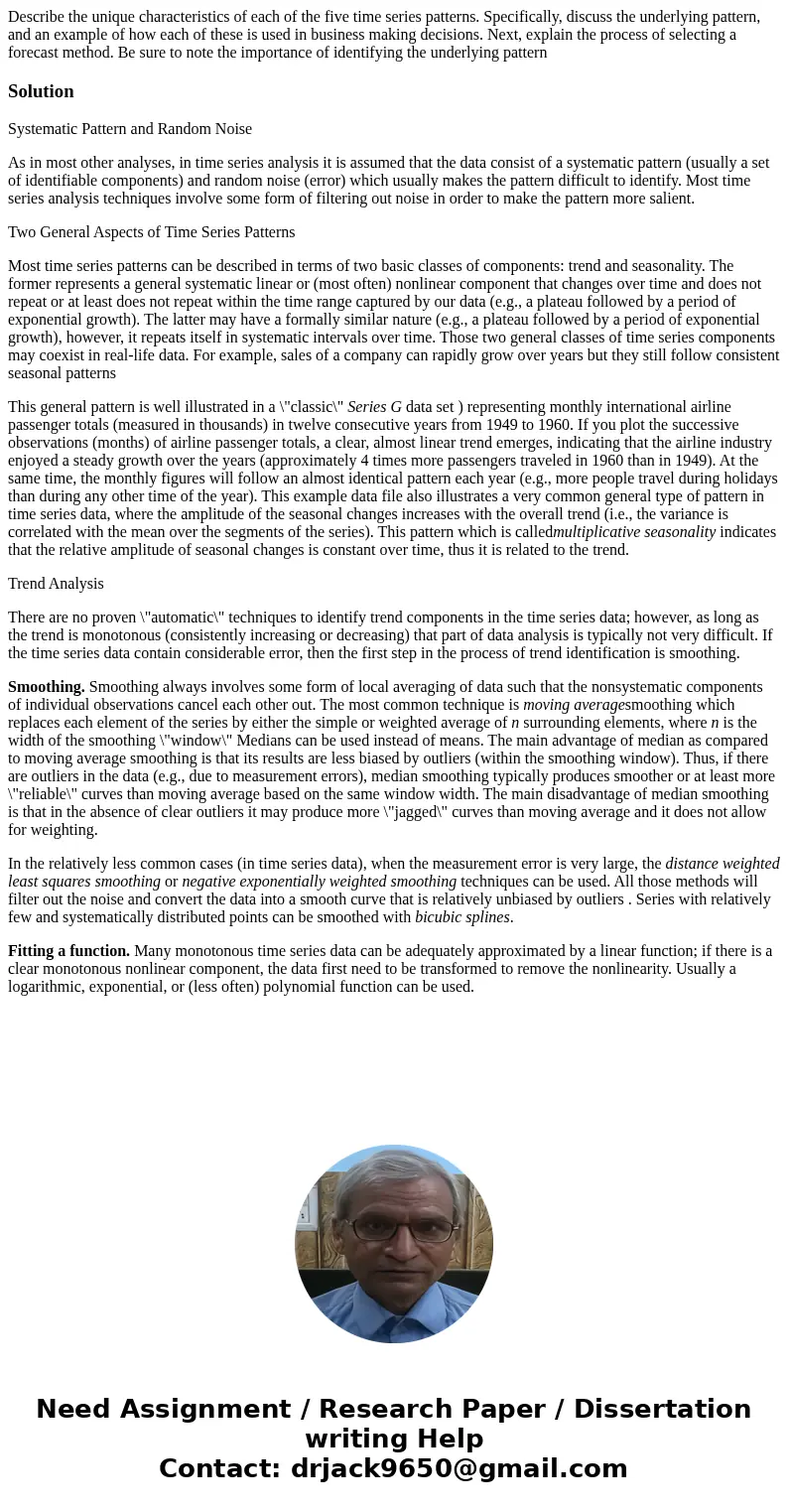Describe the unique characteristics of each of the five time
Describe the unique characteristics of each of the five time series patterns. Specifically, discuss the underlying pattern, and an example of how each of these is used in business making decisions. Next, explain the process of selecting a forecast method. Be sure to note the importance of identifying the underlying pattern
Solution
Systematic Pattern and Random Noise
As in most other analyses, in time series analysis it is assumed that the data consist of a systematic pattern (usually a set of identifiable components) and random noise (error) which usually makes the pattern difficult to identify. Most time series analysis techniques involve some form of filtering out noise in order to make the pattern more salient.
Two General Aspects of Time Series Patterns
Most time series patterns can be described in terms of two basic classes of components: trend and seasonality. The former represents a general systematic linear or (most often) nonlinear component that changes over time and does not repeat or at least does not repeat within the time range captured by our data (e.g., a plateau followed by a period of exponential growth). The latter may have a formally similar nature (e.g., a plateau followed by a period of exponential growth), however, it repeats itself in systematic intervals over time. Those two general classes of time series components may coexist in real-life data. For example, sales of a company can rapidly grow over years but they still follow consistent seasonal patterns
This general pattern is well illustrated in a \"classic\" Series G data set ) representing monthly international airline passenger totals (measured in thousands) in twelve consecutive years from 1949 to 1960. If you plot the successive observations (months) of airline passenger totals, a clear, almost linear trend emerges, indicating that the airline industry enjoyed a steady growth over the years (approximately 4 times more passengers traveled in 1960 than in 1949). At the same time, the monthly figures will follow an almost identical pattern each year (e.g., more people travel during holidays than during any other time of the year). This example data file also illustrates a very common general type of pattern in time series data, where the amplitude of the seasonal changes increases with the overall trend (i.e., the variance is correlated with the mean over the segments of the series). This pattern which is calledmultiplicative seasonality indicates that the relative amplitude of seasonal changes is constant over time, thus it is related to the trend.
Trend Analysis
There are no proven \"automatic\" techniques to identify trend components in the time series data; however, as long as the trend is monotonous (consistently increasing or decreasing) that part of data analysis is typically not very difficult. If the time series data contain considerable error, then the first step in the process of trend identification is smoothing.
Smoothing. Smoothing always involves some form of local averaging of data such that the nonsystematic components of individual observations cancel each other out. The most common technique is moving averagesmoothing which replaces each element of the series by either the simple or weighted average of n surrounding elements, where n is the width of the smoothing \"window\" Medians can be used instead of means. The main advantage of median as compared to moving average smoothing is that its results are less biased by outliers (within the smoothing window). Thus, if there are outliers in the data (e.g., due to measurement errors), median smoothing typically produces smoother or at least more \"reliable\" curves than moving average based on the same window width. The main disadvantage of median smoothing is that in the absence of clear outliers it may produce more \"jagged\" curves than moving average and it does not allow for weighting.
In the relatively less common cases (in time series data), when the measurement error is very large, the distance weighted least squares smoothing or negative exponentially weighted smoothing techniques can be used. All those methods will filter out the noise and convert the data into a smooth curve that is relatively unbiased by outliers . Series with relatively few and systematically distributed points can be smoothed with bicubic splines.
Fitting a function. Many monotonous time series data can be adequately approximated by a linear function; if there is a clear monotonous nonlinear component, the data first need to be transformed to remove the nonlinearity. Usually a logarithmic, exponential, or (less often) polynomial function can be used.

 Homework Sourse
Homework Sourse